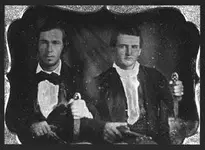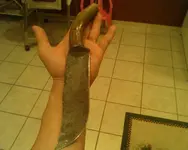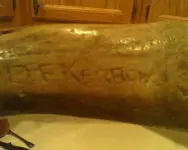THE STORY OF JAMES BLACK
SILVERSMITH - BLACKSMITH - KNIFESMITH - ARKANSAS PIONEER
Written by:
Lu Waters
Great-Great-Great-Granddaughter of James Black
James Black was born May 1, 1800, in New Jersey. He died June 22, 1872, in Washington, Arkansas. He trained as a silversmith in Philadelphia when a young boy. He emigrated to the Arkansas frontier about 1820, thus becoming a pioneer of Arkansas and a citizen of a new community where he learned a new trade as a blacksmith, fell in love, raised a family, and became a leader in the community. He is given credit for forging a knife for Jim Bowie who was a frontiersman, a speculator in land, a slave trader, and an Indian fighter.

James Black is on the right and his good friend Jacob Buzzard is on the left. Some writers have mistakenly reversed this identification.
James's mother died when he was very young. His father then married a woman with whom James could not agree. At the young age of eight, even though he looked much older, he ran away from home and made his way to Philadelphia. Apparently he was picked up by the authorities and then became indentured to a silversmith named Henderson. This arrangement was said to have been approved by his father. It was this training that he received as an apprentice that in later years enabled him to easily work with other metals and learn the trade of a blacksmith in a very short time.
James was released from his silversmith apprenticeship in 1818 but due to the British competition in the trade, he decided not to go into that business but instead he decided to go west to the American frontier to seek adventure and fortune. He traveled overland until he reach the Ohio River and then took to the waterways traveling down the big Mississippi River until he reach Bayou Sara in Louisiana. He worked on a ferry boat for a short time. Soon tiring of that, he then hired out as a deck hand on a steamboat going up the Red River. James left the boat at a point which is now know as Fulton, Arkansas. He walked up a trail running northeast for about 14 miles to a crossing of another trail where he found a few folks had already settled.
With little money and no trade that was useful on the frontier, James had to find employment. With his background in working with metals, he chose to become a blacksmith and was employed by William Shaw, a man from Tennessee who already had a shop set up. Daniel W. Jones, former Governor of Arkansas, states in "The True History of the Bowie Knife and Its Inventor, James Black" that: "In those days, the village blacksmith was a far more important man than he is now." In a short period of time, James had easily mastered the art of making plows, hoes, wagons, and other farm equipment implements as well as guns and knives. It has been stated that he was soon recognized as the best blacksmith in the country.
James enjoyed activities with the young people of the Washington community. He became close friends with the older Shaw sons, but he fell deeply in love with Anne Shaw, the oldest daughter. For reasons unknown, Mr. Shaw opposed his daughter ever marrying James Black. Evidently James became so discouraged that he gave up his work at Shaw's Blacksmith Shop and decided to travel further west. The Daniel W. Jones story tells us he selected a location on the Rolling Fork of the Cossatot River where he cleared land, built a cabin, and started to build a dam. In the fall of 1825, the sheriff appeared and informed James that his land had been ceded to the Indians and he must leave. That portion of the country became known as Indian Territory.
With no money and no place to live, James decided to go back to Washington. It was reported that he worked again for William Shaw for a short period of time but eventually opened his own blacksmith shop and begun to prosper.
In spite of her father's opposition, James Black and Anne Shaw were married in Washington, Arkansas, on June 29, 1828. The following seven years were probably the happiest years of James's life. His business was growing, and his reputation as a knife maker was spreading, and he was married to the woman he loved. Five children were born in these seven years. They were William Jefferson (1829), Grandison Deroyston (1830), Sarah Jane (1832), John Colbert (1834), and Sydinham James (1835).
James became a responsible citizen in the community and the area surrounding Washington. He was appointed to patrol the Ozan Township, appointed overseer of the road leading from Washington to the eastern boundary of the Saline Township, and appointed deputy jailor of Hempstead County by two different sheriffs. James was elected Trustee of the Town of Washington on October 27, 1834. He served on several jury panels, including an inquest jury. He bought and sold land and slaves, borrowed money, and even filed cases in court to recover money for services he had performed and had not received payment. Daniel W. Jones and Augustus Garland, both former Governors of the State of Arkansas, wrote that James had a excellent memory of frontier times and that, even in later years, was able to settle disagreements about early happenings in the county.
James Black forged a knife for Jim Bowie in his shop in Washington, Arkansas, during the winter of 1830-31. The knife pleased Mr. Bowie and from that time until his death in 1836, Jim's use of that knife acclaimed to the world that Mr. Black did indeed possess the secret of special tempering of knives. Little did James Black ever realize that in making of that knife for Jim Bowie, he would establish an enduring place for himself in the history of bladesmithing.
Of course, James Black never realized that he had influenced history in any way. But it was, at least partly, due to his reputation as the blacksmith who created one of the earliest bowie knives here in Arkansas that gave the state the nickname of the "bowie knife state."
Today, James Black is probably best remembered for the knives that he forged. There are three good examples of his work available to be seen today. The "Carrigan Knife" has the best documented history of owners, back to the time when James Black made it. This knife, along with "Bowie Number One," is currently on display at the Arkansas Territorial Restoration in Little Rock. The "Tunstall Knife," along with its documentation, is on display in the Saunders Memorial Museum in Berryville, Arkansas.
The foremost bladesmith in the world today, Bill Moran of Braddock Heights, Maryland, has made the following comment concerning knives made by James Black: "They are spectacular knives with all that gleaming silver. They are very different; they have been forged so that the tang tapers towards the blade and also tapers from the back to the edge side--never seen before in other knives. On earlier blades (ones forged prior to 1820), we've never seen a coffin-shaped handle like these."
John Fleming in his book, "The Tale of James Black...The Man Who Made the Original Bowie Knife," wrote the following: "In fiction, the life of James Black would never be believed. In fact, it has never been accorded the recognition it deserves. Washington, a forgotten crossroads, is nine miles from Hope on state Highway 4 and 18 miles from Nashville, also on Highway 4. The blacksmith shop of James Black has been restored, and the tavern where Black probably ate in his early days at Washington and where Sam Houston, Stephen Austin, and Bowie lived while in Arkansas, has been reconstructed. There is the old courthouse that served as the state capitol during the Civil War and old homes lend a touch of grandeur to the scene. Probable nowhere in the Southwest is there a better collection of pioneer antiques than in this multi-building museum complex. And, of all the wraiths that spur one's sense of history at this picturesque Arkansas village, the ghost of James Black is the most dramatic."
For more information about James Black, consult the following sources:
1) The Gazette (Arkansas Gazette), June 29, 1828; September 12,
1835; February 15, 1842; June 1872; September 1, 1872; June 11, 1908.
2) Telegraph, Washington (Arkansas), December 8, 1841
3) Arkansas Democrat: Sunday Magazine, April 16, 1941
4) Washington, Arkansas: History on the Southwest Trail (1984) by Mary Medearis.
5) American Silversmiths and Their Marks (1948) by Stephen G. C. Ensko.
6) Sam Williams: Printer's Devil (1979) by Mary Medearis.
7) The Old Town Speaks by Charlean Moss Williams.
8) Arkansas Historical Quarterly, Vol. LIII, Summer 1994, No. 2: "Arkansas and the Toothpick State Image" by William B. Worthen.
9) Congressional Record of the United States of America,
proceedings and debates of the 92nd Congress, Second Session, Washington, Monday, April 10, 1972. Senate.
10) "The Tale of the Man Who Invented the Bowie Knife" by John Fleming.
11) Bowie Knife (1948) by Raymond W. Thorp
12) Early Days in Arkansas (1895) by Judge William F. Pope
13) Hempstead County, Arkansas Court Records. July 18, 1828; June 1, 1829; October 12, 1832; April 7, 1834; October 27, 1834; May 11, 1836; December 12, 1836; February 4, 1837; April 6, 1837; April 15, 1837; May 28, 1838; August 13, 1838; January 16, 1839; August 24, 1839; October 6, 1839; October 7, 1839; January 16, 1840; February 15, 1840; October 25, 1841; April 1844 Term of Court; July 1844 Term; July 1848 Term; October 3, 1870.
14) Original "Loose" Court Records of Hempstead County, Arkansas (Found at Southwest Arkansas Regional Archives): October 7, 1835; November 19, 1835; prior to June 15, 1836; April 6, 1837; January 16, 1839; July 22, 1839; April 2, 1866.
15) Probate Court Records of Hempstead County, Arkansas: October 25, 1841.
16) Territorial and Hempstead County Tax List, 1829, showing James Black in area.
17) Letters of Administration of Hempstead County, Arkansas, August 24, 1839.
18) KNIFE WORLD (Magazine), December 1992, Volume 18, Number 12
19) American Arms Collector Magazine, July 1957, "The Legend of James Black" by Ben Palmer.
20) Muzzleloader (Magazine), October 1974, "Bowie and Black Legend or Fact?" by B. R. Hughes.
21) Muzzleloader (Magazine), July/August 1975, "Another BLACK Knife is Located" by William Ward.
22) Dixie, Times-Picayune States Roto Magazine, October 20, 1957, "Who Invented the Bowie Knife?" by Karr Shannon.
23) Guns & Ammo Annual 1991, "Jim Bowie's IRON MISTRESS -- Reel Knife vs. Real Knife" by Joe Musso.









